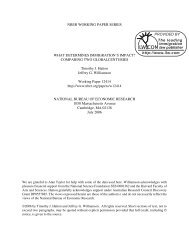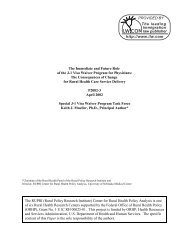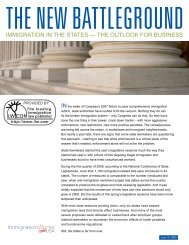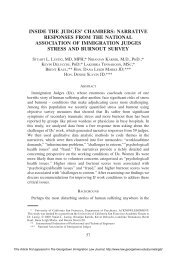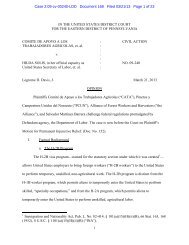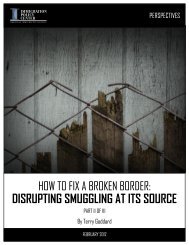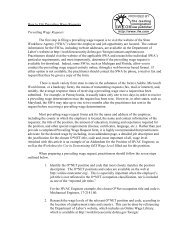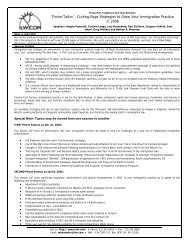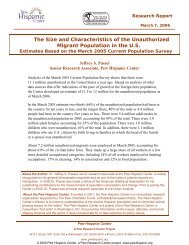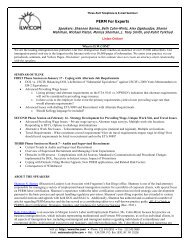Study of Board of Immigration Appeals Procedural Reforms - ILW.com
Study of Board of Immigration Appeals Procedural Reforms - ILW.com
Study of Board of Immigration Appeals Procedural Reforms - ILW.com
You also want an ePaper? Increase the reach of your titles
YUMPU automatically turns print PDFs into web optimized ePapers that Google loves.
the Department’s enactment <strong>of</strong> the <strong>Procedural</strong> <strong>Reforms</strong> was “not arbitrary or capricious, or<br />
otherwise in violation <strong>of</strong> the law.” 145<br />
The plaintiffs had argued that three aspects <strong>of</strong> the final rule were arbitrary and capricious:<br />
(1) “the decision to adopt the streamlining provision as the dominant method <strong>of</strong> adjudication;”<br />
(2) “the provision reducing the size <strong>of</strong> the <strong>Board</strong> from 23 members to 11;” and (3) “the sixmonth<br />
transition period designed to reduce the <strong>Board</strong>’s backlog.” 146 The court addressed each <strong>of</strong><br />
these issues in turn.<br />
First, the court held that the Department made a reasoned decision to adopt the expanded<br />
streamlining procedures articulated in the “<strong>Procedural</strong> <strong>Reforms</strong>” based upon three factors which,<br />
although “not altogether free from doubt,” tended to support the Department <strong>of</strong> Justice’s<br />
decision: (1) “Andersen’s favorable audit <strong>of</strong> the streamlining initiative,” (2) “Congressional<br />
testimony reflecting a continued need for <strong>Board</strong> reform,” and (3) “the Department’s own internal<br />
statistics and assessment.” 147 The court concluded that the Department’s “decision to expand the<br />
streamlining procedure to most <strong>Board</strong> cases is supported ‘by substantial evidence.’” 148<br />
Second, the court held that the Department <strong>of</strong> Justice’s decision to reduce the size <strong>of</strong> the<br />
BIA was influenced by “two important intervening events . . . that convinced the Department to<br />
adopt a revised policy <strong>of</strong> <strong>Board</strong> reduction: Arthur Andersen’s favorable audit <strong>of</strong> the 1999<br />
streamlining project and the February 6, 2002, hearing on immigration reform before the House<br />
Sub<strong>com</strong>mittee on <strong>Immigration</strong>.” 149 It found that based upon these two events, the Department’s<br />
conclusion to reduce the size <strong>of</strong> the BIA was reasonable and appropriate as the Department had<br />
“examine[d] the relevant data and articulate[d] a satisfactory explanation for its action.” 150<br />
Finally, the court examined the challenge to the six-month transition period. The court<br />
rejected the plaintiffs’ argument “because its statistical basis is flawed and does not recognize the<br />
positive impact streamlining has already had on the case backlog.” 151<br />
At the time this <strong>Study</strong> was released, there had been no appellate review <strong>of</strong> the district<br />
court’s judgment or reasoning.<br />
145 See id. at *21.<br />
146 Id. at *9.<br />
147 Id. at *10.<br />
148 Id. at *15.<br />
149 Id. Reliance on the Andersen Report as support for the “<strong>Procedural</strong> <strong>Reforms</strong>” seems misplaced. The Andersen Report actually concluded<br />
that the “Streamlining Rules” had been an “unqualified success” and “should remain viable and can be sustained…” That report does not<br />
discuss or support a reduction in the number <strong>of</strong> BIA board members. See Andersen Report, supra note 74. The Andersen Report does not<br />
support the 2002 rule changes; rather, the Andersen Report seems to provide a reason not to promulgate them.<br />
150 CAIR Opinion, supra note 143, at *19 (quoting Motor Vehicles Mfrs. Ass’n v. State Farm Mut. Automobile Ins. Co., 463 U.S. 29, 42<br />
(1983)).<br />
151 Id. at *20. The court also noted that because the extended transition period was close to <strong>com</strong>pletion, plaintiffs’ challenge to this aspect <strong>of</strong><br />
the <strong>Procedural</strong> <strong>Reforms</strong> was not timely. Id. at *21, n.23.<br />
30



